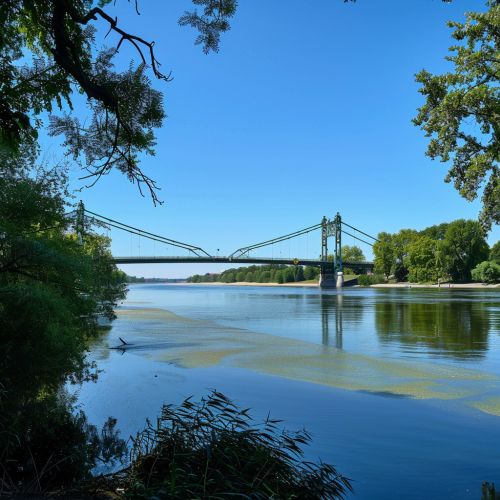Dessau Bridge
History and Construction
The Dessau Bridge, located in Dessau, Germany, is a significant historical and architectural landmark. Constructed in the early 20th century, the bridge spans the Elbe River and serves as a crucial connection between the northern and southern parts of the city. The bridge was initially designed to accommodate both vehicular and pedestrian traffic, reflecting the growing need for infrastructure to support urban expansion and industrial development in the region.
The construction of the Dessau Bridge began in 1910 and was completed in 1913. The project was overseen by the renowned German engineer Friedrich von Thiersch, who was known for his expertise in bridge design and construction. The bridge's design incorporates elements of both classical and modern engineering principles, making it a unique example of early 20th-century bridge architecture.


Architectural Features
The Dessau Bridge is a steel arch bridge, characterized by its elegant and robust structure. The main span of the bridge measures approximately 200 meters, making it one of the longest bridges of its kind in Germany at the time of its completion. The bridge's arches are constructed from high-strength steel, which was a relatively new material in bridge construction during the early 20th century. This choice of material allowed for a more slender and aesthetically pleasing design compared to traditional stone or brick bridges.
The bridge's deck is supported by a series of vertical hangers that transfer the load from the deck to the arches. This design not only provides structural stability but also creates a visually striking appearance. The deck itself is composed of reinforced concrete, which was chosen for its durability and ability to withstand heavy traffic loads.
Engineering Innovations
One of the most notable engineering innovations of the Dessau Bridge is its use of the cantilever construction method. This technique involves constructing the bridge in segments that project horizontally from piers without the need for temporary supports. The cantilever method was particularly advantageous for the Dessau Bridge due to the wide span of the Elbe River and the need to minimize disruption to river traffic during construction.
The bridge also features an advanced system of expansion joints and bearings that allow for thermal expansion and contraction. This is crucial for maintaining the structural integrity of the bridge, as temperature fluctuations can cause significant stress on the materials. The use of these components reflects the advanced understanding of material science and structural engineering principles at the time.
Impact on Urban Development
The completion of the Dessau Bridge had a profound impact on the urban development of Dessau. By providing a reliable and efficient means of crossing the Elbe River, the bridge facilitated the expansion of residential and commercial areas on both sides of the river. This, in turn, contributed to the economic growth of the city and the surrounding region.
The bridge also played a key role in the development of the Bauhaus movement, which was founded in Dessau in 1919. The Bauhaus school of design and architecture emphasized the integration of art, technology, and craftsmanship, and the Dessau Bridge served as an inspiration for many of the movement's principles. The bridge's combination of functional engineering and aesthetic design exemplifies the Bauhaus philosophy of form following function.
Preservation and Restoration
Over the years, the Dessau Bridge has undergone several preservation and restoration efforts to maintain its structural integrity and historical significance. In the 1980s, a major restoration project was undertaken to address issues related to corrosion and material degradation. This project involved the replacement of several key structural components and the application of protective coatings to prevent further deterioration.
In recent years, the bridge has been designated as a protected historical monument, ensuring that it will be preserved for future generations. Ongoing maintenance efforts include regular inspections, structural assessments, and minor repairs as needed. These efforts are crucial for preserving the bridge's historical and architectural value while ensuring its continued functionality as a vital transportation link.
Cultural Significance
The Dessau Bridge holds a special place in the cultural heritage of Dessau and the broader region. It is not only a testament to the engineering prowess of the early 20th century but also a symbol of the city's resilience and growth. The bridge has been featured in numerous works of art, literature, and photography, highlighting its iconic status and enduring appeal.
The bridge is also a popular destination for tourists and locals alike, offering stunning views of the Elbe River and the surrounding landscape. Its central location makes it easily accessible, and it serves as a focal point for various cultural and community events throughout the year.
